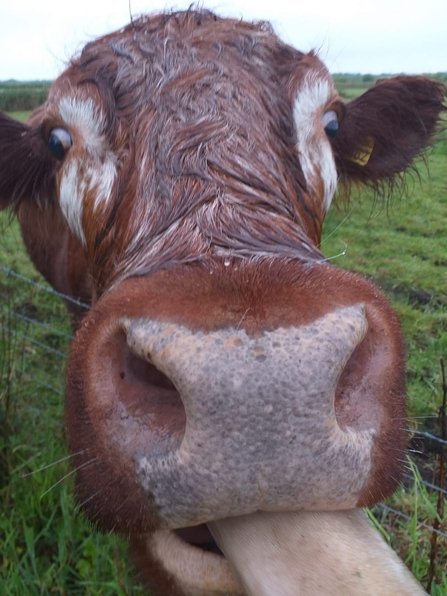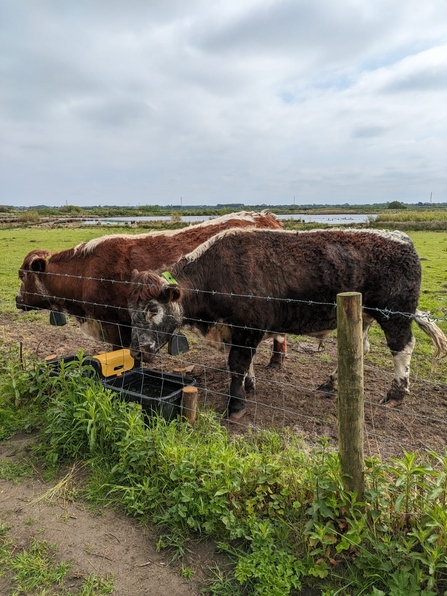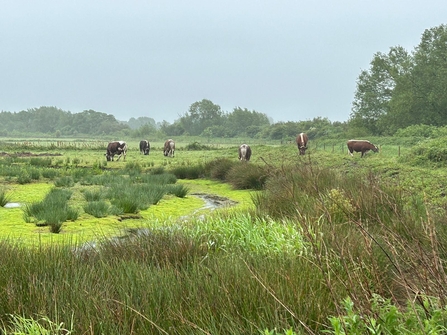If you’ve been to Lunt Meadows since mid-April, you most probably spotted six rather large (and very friendly) brown and white cattle in our wet grasslands. These lads are important four-legged members of our conservation grazing department. Ulrik, Uber, Ulysses, Uther, Uhtred and, leader of the herd, Usain, will be spending the summer months grazing the grasslands on the reserve, improving the habitats for wildlife and visitors alike.
Have you heard about conservation cattle?
Why are there cattle on Lunt Meadows?
Our cattle aren’t used for traditional farming practices; instead they are important members of our conservation team, helping to improve our habitats by acting as lawnmowers. An ideal grassland habitat is open, with a variety of plants and flowers of different heights and minimal tree coverage. However, grasslands are transitional habitats, meaning if they were left unmanaged, they would eventually turn into woodlands. If trees were allowed to dominate, all the specialist wildlife found in the grassland, such as hares, lapwing, and many invertebrates, would be displaced and replaced by woodland species (this is a process called succession).
Thousands of years ago, now-extinct herbivores like aurochs and elk would have roamed the British Isles, naturally maintaining open areas by eating scrub, tough grasses, and tree saplings. We could send people out cutting the grass and pulling up trees, and we do sometimes do this, but a more natural and effective management approach is to use grazing animals to replicate our wild herbivores.

Longhorn cattle are known for their docile nature, This one is very friendly by Jeanette Tunstall.
The cattle are not picky eaters, and able to wrap their tongues around large chunks of grass and pull, leaving bare ground for new seeds to grow and creating a habitat with varying heights of plants, ideal for invertebrates. Their dung is fantastic for invertebrates too, adding nutrients to the soil and helps to transport seeds around the site.
Cattle are particularly good for our needs at Lunt Meadows, because their trampling and feeding habits allow us to manage the site more efficiently. For example, you might spot the cattle ripping the leaves off the willow trees sprouting up near the water. From a visitor perspective, the willow also blocks the view for anyone trying to watch wildlife. From a wildlife perspective, the willow provides cover for any approaching predators, so removing it is important to create open spaces for wading birds to feel safe to breed and roost in. The birds see humans as predators, and as we want to limit disturbance to them, especially during breeding bird season, the non-threatening (to birds) cattle can get closer and clear the willow instead.
What breed of cattle are they?
This herd are all longhorns, an old northern English breed of cattle. Longhorns are known for their docile nature and hardiness in poor weather. Born in the same year, these cattle have all been together since they were very young. They are all around 3-4 years old and are content in each other’s company. All six boys had their horns removed before joining our grazing team, as they have been in mixed breed herds before and may be again one day. While longhorns are used to avoiding other cattle with horns, the risk of other breeds getting injured by an accidental poke of the horn is high. Removing horns does not hurt the cattle.

Usain, with the darker brown colouring, is the leader of the herd by Molly Toal
What are they wearing round their necks?
The cattle are all wearing solar-powered GPS collars, called NoFence, which is the world’s first virtual fencing system. NoFence is controlled by a phone app and allows the Trust’s conservation team to create virtual boundaries for livestock on their mobiles and view the cattle’s live location every 15 minutes.
The cattle have all been trained on NoFence, so they are comfortable wearing the collars. If one of the cattle approaches the virtual boundary line, the collar gives an audible warning that gets louder as they get closer to the boundary. If they ignore the audible warning, they receive an electrical pulse, like that of an electric fence. With training, the cattle understand the meaning of the audible warning and usually turn around when they hear it, but if they need to escape the boundary for any reason, the electric pulse stops after three pulses.
What are the benefits of NoFence collars?
NoFence allows the conservation team to monitor the cattle’s live location from anywhere when viewing the app, regardless of the staff member’s whereabouts at the time, and the collar sends an alert if an animal hasn’t moved for a certain amount of time. These features, alongside daily in-person visual checks carried out by livestock volunteers, are helpful in ensuring the animals’ welfare.
The app has further benefits for managing the cattle for conservation grazing. If there is an area we wish to target graze, a boundary can be set up to place the cattle in there and the cattle can be moved across within a few hours. This saves a significant amount of time and money that would otherwise be spent on building a physical fence and means resources can go into other tasks.
In addition, NoFence allows the team to create exclusion zones within a boundary. For example, the Lunt team identified that the cattle had been eating water hemlock, a poisonous plant, within the grasslands. So the Grazing Project staff were able to stop the cattle from doing this by setting up an exclusion zone around the plant.
Can the public use NoFence to look at the cattle?
Yes, if you are within 20km of the cattle, anyone with a smartphone with location settings turned on can view the herd on a map using this link.

The cattle grazing in the wet grassland at Lunt Meadows by Cheryl Ashton
We would like to thank Lunt Meadow’s amazing conservation volunteers for working so hard on getting the grasslands safe for the cattle to arrive, and to the dedicated livestock volunteers too, who visit site each day to make sure the cattle are looking well.
All our conservation work at Lunt Meadows is part of The Presenting Mesolithic and Modern Life Project, made possible through The National Lottery Heritage Fund. Thanks to National Lottery players, we have been able to bring these cattle onto site and use them to improve the reserve for site users, be they wildlife or human.
Thank you also to the Haplin Trust, who have funded the purchase of the Trust’s NoFence collars.
To find out more about Lunt Meadows and to plan your visit, see Lunt’s reserve page.

